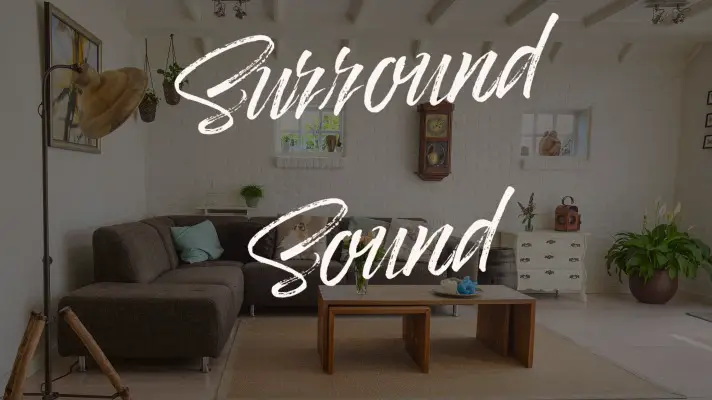So, you’ve recently started to grow the idea of adding more sound to your room, but still, you do not want to put holes in your pocket by getting a full surround sound system. You’re thinking, will adding a few speakers to my soundbar do the magic of giving me surround sound?
Well, you can do this, even though it’s complicated in a way. The best option might be to get a soundbar that came with its surround sound speakers, either wired or wireless, though there are very few soundbars in this category. But you already have a soundbar and you do not want to ditch the soundbar you are currently using. There are ways to do this, but please bear in mind the setup is way complicated because most soundbars do not have the capacity for external speakers connection that was not manufactured together with it to be incorporated as part of its system.
How Do Soundbars Operate?
To perform this soundbar-speaker combination, you need to first understand how soundbars work or operate. Soundbars were designed to replicate the sound you would normally get from a surround sound system. One way it does this is by producing sounds that travel to hit the wall of your room, which then ricochets off the wall, giving you an immersive sound like that of surround sound, because of its angled speakers.
Now, when you add surround sound speakers to your soundbar, you amplify an already amplified sound, and you know what this can cause. Because they are separate working devices, there could be a lag or a slight difference in transmitting time for the audio from both. This will cause the audio to be jumbled up. Also, there could be audio interference to the soundbar leaving different spots in your room with different sound levels.
The few instances where Soundbars can be connected to surround sound is not a straight forward setup and will end up with more wires. So, if you are that type of person that hates having too many cables or wires hanging out from a device, then you probably might want to have a rethink about this combination.
Can A Soundbar Work Well Together With Other Speakers?
Sure! Depending on factors like the connectors present in your output devices, the external speakers and soundbars models, etc. A soundbar working together is achievable, albeit, can be complicated. This article will provide guides on how to make this work.
For a start, please bear in mind that speakers cannot be connected directly to a soundbar, there has to be an intermediary between both. The idea of connecting both your soundbar and speakers to a splitter using optical cables is another option. However, the sound produced may not sync from both devices, leaving you with a not so palatable audio taste. This is why a combination of soundbar and speakers is not ideal, and the thought of having so many cables too! However, for those who are adamant about this combination, we are here to provide a guide to achieving this combination.
How To Connect Surround Sound Speakers And Soundbars
To connect surround sound speakers to soundbars, there are definite things required for this setup. They are listed below.
Soundbar with Digital optical input, RCA, and Aux options.
RCA cables.
Also required are surround sound speakers that can connect wirelessly or use regular speaker cables to connect to the receiver.
A 5.1 channel AV receiver. It should have both left and right front channels pre-outs as well as center channels pre-outs. A pre-out serves to connect an external amplifier, so, rather than use the receiver’s in-built amplifier, the pre-out is used to connect an external amplifier.
Finally a stereo mini mixer with more than 2 inputs, and at least a single output. The work of the stereo mini mixer is very important. What it does is that it accepts audio from different sources through its input channels, adjusts sound levels and its other attributes, and then combines them to a lesser or mono output.
Now, let’s look at the steps needed to achieve this setup.
Step 1: First thing you need to do is connect the RCA cables to the receivers’ front left and right, and center channels pre-outs. As earlier explained, the pre-outs serves as an output for audio signals for each channel, more like a “middle man” for the audio signal. Please note the pre-outs are very different from the output you have in your regular speakers. If you go ahead to connect your soundbar to the output of a regular speaker, you might as well get a new soundbar, because, once it is powered, power will go directly to the soundbar, which will certainly cause damage to its interior.
Step 2: Next thing to do is connect the other ends of the RCA cables to the stereo mini mixer.
Step 3: This is where you connect the stereo mini mixer’s output to the soundbar. As earlier stated, your soundbar should have Digital optical, RCA, and Aux input options. Using the RCA input option on your soundbar, connect another set of RCA cables to the stereo mini mixer’s output, and then connect the other end of the RCA cable to the RCA input of the soundbar. If your soundbar does not have an RCA input but has AUX input, then you will need to get an RCA to Aux cable to make the connection. The RCA end of the cable goes into the stereo mini mixer’s RCA’s input, while the Aux end of the cable goes into the Aux port on the soundbar. If your soundbar is still missing an RCA and Aux input, which by the way is rare, then a third option will be to use the Digital Optical input. To use this, you’ll need an analog to digital optical converter. First of all, you’ll need to connect one end of RCA cables to the stereo mini mixer’s RCA output, and the other ends into your converter. Then connect one end of your digital optical cable to your converter and the other end to your soundbar.
Step 4: This is where you connect your surround speakers to your receiver. This is done using regular speaker wires, or you can go wireless if that option is feasible and available. The number of surround speakers you connect to the receiver will depend on how much the receiver can take.
What Other Methods Can Be Used To Make A Surround Sound Work Together With A Soundbar?
We have discussed above the methods for connecting surround sound speakers to soundbars. So, what other methods are out there you may be wondering. There aren’t too many options available, however, you could consider the two options mentioned below.
Make use of officially supported surround sound speakers for your soundbar. These surround sound speakers are often manufactured together with the accompanying soundbars. This should be the first option for you when thinking of soundbars and surround sound speakers working together.
Another option will be to use a kit that includes a transmitter, receiver, and sometimes speakers. This is a universal rear speaker kit and could help achieve the purpose, though, your soundbar model has a huge role to play in the success of this setup.
Some Extra Information You Need To Know
First of all, congratulations on finally getting your surround sound speakers, and soundbar working together. Since these setups are not part of the manufacturer’s guide and are more of DIY, you may need to make some tweaks and audio adjustments to get the audio working. Keep trying different configuration settings, and be sure to check on your device’s audio output settings to achieve the desired audio.
Is This Surround Sound Speakers-Soundbar Connection Worth It?
Let’s face it, it’s a lot complicated setting up the surround sound speakers and soundbar to work together, also not to mention the cables. This may not be a great idea if you have little children in your home, they just might get tempted with the many cables they see.
Depending on the soundbar you have, whatever the number of speakers you are adding to the soundbar, can only mimic the audio quality from a full surround sound system, and will still not be as good as a full surround sound system, because that high-definition audio you are looking to have will not be possible to achieve. Also, you end up with more converters, more cables, and the whole thing might end up ruining the audio quality.
It’s therefore, best to stick to either a soundbar setup or a surround sound system setup, as combining both can be very tricky and complicated and may leave things worse than the first. If you have to do both then go for soundbars that are manufactured together with surround sound speakers.
Conclusion
In this article, we have looked at the possibility of adding surround sound to a soundbar and how to go about it. However, soundbars are a “one-man-army”. They do not need any assistance or support to work. It is doing its best to imitate surround sound, therefore adding more speakers to the mix will only interfere rather than assist. If you are still very bent on having a surround sound experience, then it’s better to get a soundbar that includes the surround sound system or better still, stick to just the full surround sound system leaving out the soundbar.

Sam has been a Smart Things expert for years and the author of DIY SmartThings. Recently he’s really more into Nest smart devices and has a lot of experience with all sorts of projects from converting a regular Home to completely a smart home with the background degree in Electronics.
